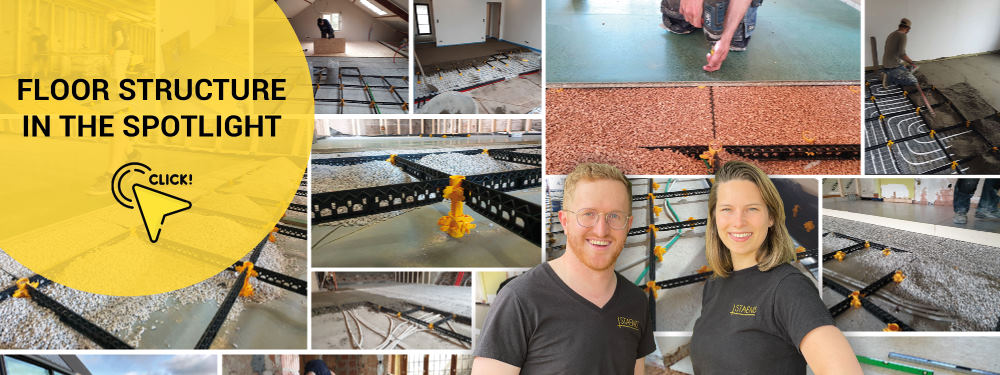Manual and important points of attention for the StaenisGrid:
Screed
Processing temperature
Only install screed at temperatures between 10°C and 20°C, as this ensures that the screed will not become sandy or come loose. Also make sure that the screed feels fresh/cold during installation or that the ambient temperature does not drop below 5°C.
Permitted floor coverings
Tiles (ceramic tiles and natural stone), parquet, floating floor coverings, carpet, and all other floor coverings, except cork and poured floors, can be placed directly on the screed (for all types of cork and poured floors, first apply a leveling compound).
If you want a poured floor as a floor finish, you need to use screed and on top of that a fiber-reinforced leveling compound with a thickness of 3 mm. Make sure that the fibers in the leveling compound are evenly distributed and oriented in all directions. It is also important that the screed can dry thoroughly. To do this, polish the top layer of the screed well during installation and immediately cover it with construction foil for 7 days to prevent sand formation. Allow the screed to dry for at least 28 days and check the moisture content according to the requirements of the poured floor.
Primer
Always use and apply a suitable primer on the screed before installing the floor covering.
Point load screed with Staenis grid
- Maximum point load (⌀ 10 cm) of 1 ton (1000 kg) allowed on a screed with a thickness of 6 cm.
- Maximum point load (⌀ 10 cm) of 1.5 tons (1500 kg) allowed on a screed with a thickness of 9 cm. The above screeds (200 kg cement / m³) are both installed on insulation. If the screed is installed on a concrete substrate, where it cannot subside, the regulated compressive strengths for screeds according to the standards of the WTCB apply.
Expansion joints
-
Surfaces without expansion joints may not exceed 200 m².
For surfaces larger than 200 m², please contact us.
NOTE: an expansion joint must be installed if the opening is less than 110 cm. - Construction joints must always be carried over, as prescribed by the BBRI.
- Edge insulation (perimeter joints) still needs to be installed.
Installation methods
There are 2 different installation methods to install the grid in your space.
- Row by row: Place a row of StaenisGrids - Rotate the StaenisGrid to the correct height - Fill the StaenisGrid with screed - Level it to the top of the grid - Repeat until the entire area is finished.
- Pre-installed: Place all StaenisGrids in the room - Adjust all StaenisGrids to the correct height - Fill the StaenisGrid with screed - Level it to the top of the grid - Check the height of the grid - Repeat until the entire room is finished.
Secure the grids by placing weight in or on a compartment. Click a row of slats out of the grid to allow passage with a wheelbarrow. Because the grid is fixed, the spacing will remain the same after separating the row of slats.
Placement of StaenisGrid
- Place the frames by clicking the slats and legs together.
- Shorten the slats at the wall by sawing or grinding them. The maximum distance from the grid to the wall is 5 cm.
- At the connection to the wall, you can stabilize the grid by clicking legs sideways into the slat. At both ends of the slat, a third type of click connection can be seen. This allows you to connect two slats with a sideways leg to each other using a slat. Note that the slat then only clicks in one direction.
- Raise or lower the StaenisGrid with a screwdriver by turning the adjustment screw to the left or right.
Substrate
With a resilient insulation substrate, place the grid loosely and fill the center with a heap of screed; this pushes the insulation down. Only then adjust the grid to the correct height. Always check the height of the applied screed after screeding with a straightedge, long level, or laser.
Height adjustment
The highest flatness can be achieved with a laser that you align with a line on a wooden tool/lat or folding ruler. Once you use a digital receiver, the screed will inevitably cause height differences of a few millimeters. A digital water level hose is also not recommended. Try to use a digital receiver or water level hose only to mark out a few points, so that you can level everything in between using a stretched string or aluminum straightedge.
Accuracy
We ask you to pay close attention to the height adjustment during installation and to regularly check the flatness with a long aluminum straightedge or laser.
Processing
- The screed may be applied at different times, as the screed is interrupted by the grids. However, always click the next row of grids into place to prevent the screed from drying out in the click system, which could cause the click system to no longer function properly.
- The grid must be clicked together over the entire surface. If this is not possible, an expansion joint must be placed between the two surfaces with grids.
- The grid must be placed no more than 5 cm from the wall at all points in order to maintain the benefits of the StaenisGrid. If this is not applied correctly, no guarantee can be provided.
Waiting time
If you use a traditional sand-cement screed, you must wait at least 28 days before installing a floor covering. This period can be extended or shortened by using different screeds with different types of floor coverings. Always consult the manufacturer of the screed and the floor covering for this. It is permitted to start the covering earlier than 28 days with fast-drying screed or special tile adhesive, but always consult the manufacturer's technical data sheets for correct installation.
Underfloor heating
Always let the screed go through a standard heating cycle before starting to tile. The underfloor heating can already be started 7 days after the screed has been installed. After 28 days, the screed is always ready to be tiled, regardless of the screed thickness. For parquet, a moisture measurement must be carried out by the parquet installer before starting the installation.
Dispersion agent
It is not necessary to add a dispersion agent to the screed when using underfloor heating in combination with the StaenisGrid. The dispersion agent ensures that less water is needed when preparing and processing the screed. However, the difference in heat conduction, with or without a dispersion agent, is minimal and not noticeable when the house/underfloor heating is put into use. If you still choose to use a dispersion agent, you can ask the screed silo supplier (De Fauw) to provide this system. Alternatively, you can also rent a water pump and tub from Boels. Fill this tub with water and the dispersion agent. Place the water pump in the full tub and pump the water to the screed silo.
You can also fill a water bottle with the dispersing agent. Make a hole in the cap. When the mixer is running in the silo, turn the bottle upside down so that the dispersing agent flows into the screed. Turn the bottle back when the mixer stops. In this way, the dispersing agent mixes with the screed.
Placement of screed
- Fill the StaenisGrid with screed and place it just slightly higher than the top surface of the grid. Try to lightly press the screed with your trowel.
- Take a long screed bar or aluminum straightedge and drag all the excess screed off the grid. This way, the screed is now level with the top surface of the grid.
- Sprinkle screed by hand onto the surface and rub it in with a large float. This will ensure that all irregularities are filled in. Be sure to check that you do not create any dips or bumps in the compartment and always keep it level.
- For extra adhesion and flatness, take the screed iron again and polish the screed by holding the screed iron slightly tilted (3 degrees up) and rubbing it over the surface.
- Check and correct each cell for flatness to avoid hollows in the grid. This is a very important step that must be carefully observed.
Only manually compact/polish the screed with a screed trowel and compact it with a large float. Do not compact the screed with your feet. This can cause the mesh to be pressed into the underlying insulation, resulting in height differences.








